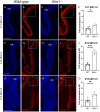Wnt1 Role in the Development of the Habenula and the Fasciculus Retroflexus
- PMID: 34722541
- PMCID: PMC8551717
- DOI: 10.3389/fcell.2021.755729
Wnt1 Role in the Development of the Habenula and the Fasciculus Retroflexus
Abstract
Wnt1 is one of the morphogenes that controls the specification and differentiation of neuronal populations in the developing central nervous system. The habenula is a diencephalic neuronal complex located in the most dorsal aspect of the thalamic prosomere. This diencephalic neuronal population is involved in the limbic system and its malfunction is related with several psychiatric disorders. Our aim is to elucidate the Wnt1 role in the habenula and its main efferent tract, the fasciculus retroflexus, development. In order to achieve these objectives, we analyzed these structures development in a Wnt1 lack of function mouse model. The habenula was generated in our model, but it presented an enlarged volume. This alteration was due to an increment in habenular neuroblasts proliferation rate. The fasciculus retroflexus also presented a wider and disorganized distribution and a disturbed final trajectory toward its target. The mid-hindbrain territories that the tract must cross were miss-differentiated in our model. The specification of the habenula is Wnt1 independent. Nevertheless, it controls its precursors proliferation rate. Wnt1 expressed in the isthmic organizer is vital to induce the midbrain and rostral hindbrain territories. The alteration of these areas is responsible for the fasciculus retroflexus axons misroute.
Keywords: Wnt1; differentiation; fasciculus retroflexus; habenula; proliferation.
Copyright © 2021 Company, Moreno-Cerdá, Andreu-Cervera, Murcia-Ramón, Almagro-García, Echevarría, Martínez and Puelles.
Conflict of interest statement
The authors declare that the research was conducted in the absence of any commercial or financial relationships that could be construed as a potential conflict of interest.
Figures







Similar articles
-
Adhesion molecule Amigo2 is involved in the fasciculation process of the fasciculus retroflexus.Dev Dyn. 2022 Nov;251(11):1834-1847. doi: 10.1002/dvdy.513. Epub 2022 Jul 2. Dev Dyn. 2022. PMID: 35727300 Free PMC article.
-
Untangling the dorsal diencephalic conduction system: a review of structure and function of the stria medullaris, habenula and fasciculus retroflexus.Brain Struct Funct. 2020 Jun;225(5):1437-1458. doi: 10.1007/s00429-020-02069-8. Epub 2020 May 4. Brain Struct Funct. 2020. PMID: 32367265 Review.
-
Netrin 1-Mediated Role of the Substantia Nigra Pars Compacta and Ventral Tegmental Area in the Guidance of the Medial Habenular Axons.Front Cell Dev Biol. 2021 Jun 8;9:682067. doi: 10.3389/fcell.2021.682067. eCollection 2021. Front Cell Dev Biol. 2021. PMID: 34169076 Free PMC article.
-
Tcf7l2 plays crucial roles in forebrain development through regulation of thalamic and habenular neuron identity and connectivity.Dev Biol. 2017 Apr 1;424(1):62-76. doi: 10.1016/j.ydbio.2017.02.010. Epub 2017 Feb 20. Dev Biol. 2017. PMID: 28219675
-
The dorsal diencephalic conduction system in reward processing: Spotlight on the anatomy and functions of the habenular complex.Behav Brain Res. 2018 Aug 1;348:115-126. doi: 10.1016/j.bbr.2018.04.018. Epub 2018 Apr 21. Behav Brain Res. 2018. PMID: 29684476 Review.
Cited by
-
Understanding the habenula: A major node in circuits regulating emotion and motivation.Pharmacol Res. 2023 Apr;190:106734. doi: 10.1016/j.phrs.2023.106734. Epub 2023 Mar 16. Pharmacol Res. 2023. PMID: 36933754 Free PMC article. Review.
-
GPR139, an Ancient Receptor and an Emerging Target for Neuropsychiatric and Behavioral Disorders.Mol Neurobiol. 2025 Jul;62(7):9324-9337. doi: 10.1007/s12035-025-04828-2. Epub 2025 Mar 18. Mol Neurobiol. 2025. PMID: 40102345 Free PMC article. Review.
References
-
- Barth K. A., Kishimoto Y., Rohr K. B., Seydler C., Schulte-Merker S., Wilson S. W. (1999). Bmp activity establishes a gradient of positional information throughout the entire neural plate. Development 126 4977–4987. - PubMed
LinkOut - more resources
Full Text Sources
Molecular Biology Databases
Research Materials

